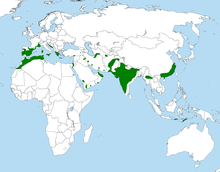Bonelli's eagle
| Bonelli's eagle | |
|---|---|

| |
| Perched on a tree near a wetland in Biligiri Rangaswamy Temple Tiger Reserve | |
| Scientific classification | |
| Domain: | Eukaryota |
| Kingdom: | Animalia |
| Phylum: | Chordata |
| Class: | Aves |
| Order: | Accipitriformes |
| Family: | Accipitridae |
| Genus: | Aquila |
| Species: | A. fasciata
|
| Binomial name | |
| Aquila fasciata (Vieillot, 1822)
| |

| |
| Distribution of A. fasciata | |
| Synonyms | |
| |
The Bonelli's eagle (Aquila fasciata) is a large bird of prey. Like all eagles, it belongs to the family Accipitridae.
It breeds in southern Europe, Africa both north and south of the Sahara Desert and across the Middle East and South Asia to Indonesia. It is usually a resident breeder.[1]

The Bonelli's eagle is found in hilly or mountainous habitats, with rocky walls or crags and open to wooded land, in arid to semi-moist climate, from sea level to 1500 m.[1]
Recent DNA research resulted in this species being moved, in 2014,[2] to the genus Aquila from Hieraaetus.[3]
The common name of the bird commemorates the Italian ornithologist and collector Franco Andrea Bonelli.[4]
Description
This is a medium to great sized eagle at 55–65 cm (22–26 in) in length, with a wingspan of about 150 cm (59 in). The upperparts of the adult are dark brown with a white patch between the wings. From below, the body is white with dark stripes, and the wings are blackish. The long tail is grey on top and white below and has a single broad black terminal band. The feet and eyes are yellow. Immature birds have deep buff underparts and underwing coverts, and have fine barring on the tail without the terminal band.[5]
The Bonelli's eagle is usually silent except near the nest.[5]

Behaviour and ecology
Breeding
Bonelli's eagle breeds on crags or large trees, in nests up to 2 m in diameter built up with wood sticks, re-used for many years. The breeding season, in the western part of its range, is from January to July.[1]
-
Bonelli's Eagle Male and Female Pair
-
Egg, Collection Museum Wiesbaden
-
Bonelli's eagle feeding its eaglet with a partridge
Feeding
Bonelli's eagle usually feeds on small to medium-sized birds, but sometimes also on mammals, reptiles, insects and carrion.[1] It usually hunts from cover by a quick dash from inside a tree, but it will also catch prey by quartering hill slopes like other eagles, or make a stoop from a soaring position. Most prey is taken on the ground.[citation needed]
This eagle takes large prey items, usually mammals or birds. Mammals up to the size of a hare are regularly taken, and birds up to guineafowl size.[citation needed]
Conservation and rehabilitation
Bonelli's eagles will foster orphaned chicks of the same species in an empty nest, but only if egg or chick loss has happened a few hours earlier. Also they will foster chicks during the post-fledging dependence period, and this conservation strategy may be applicable to other raptor species provided that siblicide is not common in the host species.[6]
In popular culture
In the action-adventure stealth video game, Assassin's Creed Origins, the game's protagonist, Bayek, has a companion named Senu who is a Bonelli's eagle.[7][8][9][10]
References
- ^ a b c d e Template:IUCN
- ^ http://www.iucnredlist.org/details/22696076/0 IUCN Red List
- ^ Helbig, A.J.; Kocum, A.; Seibold, I.; Braun, M.J. (2005). "A multi-gene phylogeny of aquiline eagles (Aves: Accipitriformes) reveals extensive paraphyly at the genus level" (PDF). Molecular Phylogenetics & Evolution. 35 (1): 147–164. doi:10.1016/j.ympev.2004.10.003. PMID 15737588.
- ^ Beolens, Bo; Watkins, Michael (2003). Whose Bird? Men and Women Commemorated in the Common Names of Birds. London: Christopher Helm. p. 59. ISBN 978-0713666472.
- ^ a b Svensson, Lars (2009). Guida degli uccelli d'Europa, Nord Africa e vicino oriente (in Italian). Ricca Editore. p. 100. ISBN 9788866940005.
- ^ Pande, Satish; Pawshe, Amit; Pednekar, Banda; Mahabal, Anil; Yosef, Reuven (2004). "How long is too long? A case of fostering nestling Bonelli's Eagles (Hieraaetus fasciatus)". Journal of Raptor Research. 38 (4). The Raptor Research Foundation, Inc.: 381–382.
- ^ Palumbo, Alessio (12 June 2017). "Everything You Wanted To Know of Assassin's Creed Origins, Including Ubisoft Studying NASA Documents". Wccftech. Retrieved 24 August 2017.
- ^ Blain, Louise (11 June 2017). "I've played Assassin's Creed Origins and OMG EVERYTHING has changed. Here are 8 reasons you'll be going to Ancient Egypt". GamesRadar. Retrieved 27 November 2017.
- ^ Alex V (21 June 2017). "Assassin's Creed: Origins Preview - E3 2017". New Game Network. Retrieved 27 November 2017.
- ^ Reparaz, Mikel (11 June 2017). "Assassin's Creed Origins – What you need to know abaout its new setting, new hero, and new action-RPG gameplay – E3 2017". Ubiblog. Retrieved 24 August 2017.
- Collinson, Martin (June 2006). "Splitting headaches? Recent taxonomic changes affecting the British and Western Palaearctic lists". British Birds. 99: 306–323.
- Lerner, H.R.L.; Mindell, D.P. (2005). "Phylogeny of eagles, Old World vultures, and other Accipitridae based on nuclear and mitochondrial DNA" (PDF). Molecular Phylogenetics and Evolution. 37: 327–346. doi:10.1016/j.ympev.2005.04.010. PMID 15925523.
External links
- Bonelli's eagle in Spain
- Bonelli's eagle Conservation Biology Team of the University of Barcelona
- Ageing and sexing (PDF; 5.4 MB) by Javier Blasco-Zumeta & Gerd-Michael Heinze
- BirdLife species factsheet for Aquila fasciata
- "Aquila fasciata". Avibase.
- "Bonelli's eagle media". Internet Bird Collection.
- Bonelli's eagle photo gallery at VIREO (Drexel University)
- Interactive range map of Aquila fasciata at IUCN Red List maps
- Audio recordings of Bonelli's eagle on Xeno-canto.
- Life Bonelli





